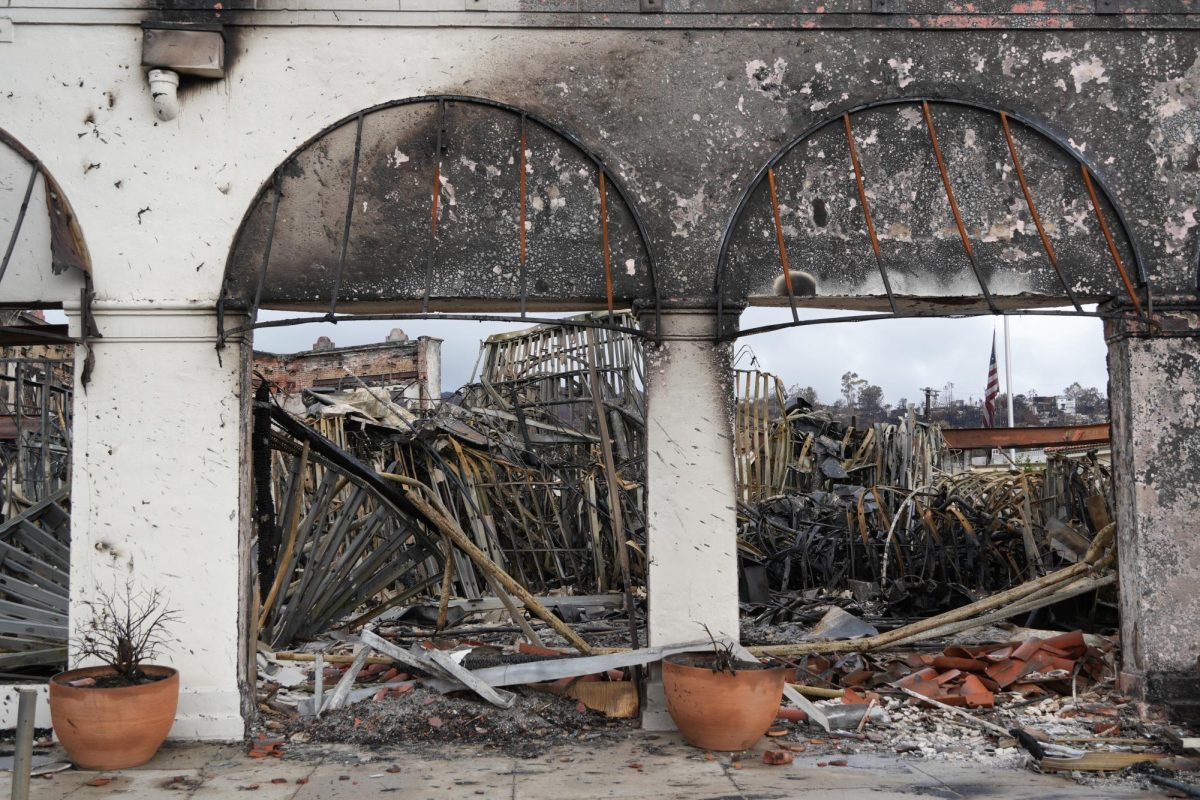By Talia ’20 and Sophie ’20

The Marlborough administration has revamped the daily schedule for the 2019-2020 school year. After a decade with the previous schedule, designed by current Director of Upper School Dr. Laura Hotchkiss ’86 and former Mathematics Department Head Dr. Chris Talone, the administration took the opportunity to formally review the schedule.
Productivity
Teachers’ feedback was heavily considered in deciding on the new schedule, specifically through a teacher committee led by Dean of Faculty Helen Mendoza and former Science Department Head Jennifer Garrison Ross.
Faculty participated in surveys throughout the process, and they were ultimately presented with the three schedule options formulated by Independent School Management (ISM), a consulting company that Marlborough enlisted to evaluate its schedule and propose changes.
Maximizing class and work time was key to developing the new schedule, from the moment the administration began corresponding with Brian Smith of ISM. To ensure that the new schedule would promote efficiency throughout the school day, ISM requested a breadth of data from Hotchkiss and the core team, which also included Director of Middle School Sean Fitts, Mendoza and Garrison Ross.
The data they collected was not the kind you would find on the Marlborough website. It ranged from statistics on classroom usage to how long it takes students to cross campus between periods.
Ultimately, the options ISM presented did prioritize productivity, especially given the decrease in class transitions. Fitts explained that even though classes start half an hour later than they previously did, school is still able to end at 3 p.m. thanks to the eight-day rotation.
The consultant even encouraged the administration to consider abolishing designated passing periods altogether. While the school chose to keep them, as a result of the new bell schedule only one five-minute passing period is necessary each day. Other classes are now broken up by community time, break and lunch, so passing periods take up much less time than they did in the previous schedule, where there would often be up to three within a single day.
Longer periods also make for longer free periods, which according to Fitts opens up the possibility of a more regulated free period for middle school students. Fitts explained that he is considering implementing study supervision for middle school students so that they can fully utilize their newfound free time.
Shared Time
In addition to longer periods, Community Time, which is shared by all students and faculty, will also serve to eliminate a passing period each day. Although Community Times will rotate between activities such as All-School Meetings, advisories and class meetings, additional Flex Times were in particularly high demand by both faculty as well as student representatives on the Student Academic Advisory Committee. This request has been addressed not only through a consistent period allotted for Community Time, but also by means of Healthy Start, which builds in a half hour of optional Flex Time every morning.
The decision to place Community Time between first and second period was deliberated throughout the process. In the previous schedule, it was most often positioned right before lunch.
“The consultant really suggested that the middle of the morning was better than abutting [community time] to lunch – people really needed a break and that also was accommodating that middle school idea,” Hotchkiss said in reference to supporting middle schoolers through longer periods of class time.
In their conversations with ISM, creating separate schedules for Middle and Upper School was also a proposal on the table, but was ultimately decided against. According to Hotchkiss, keeping both divisions on the same schedule was important in maintaining bridges between the two. For instance, separate schedules would impede on teachers who teach across both divisions.
As a result, lunch remains a shared period for all students, which Fitts suggested has some drawbacks. With the former schedule, lunch was staggered for Middle School and Upper School students on Wednesdays. Now, lunch will land consistently at the same time for every student, resulting in longer lines in Café M.
Late Start
The administration predicts that late start will help students get ahead. Classes now begin at 8:30 a.m. rather than 8:00 a.m..
Marlborough initiated the change in part to save students sleep. The CDC and American Academy of Pediatrics recommends schools start at 8:30 a.m. or later so students have the opportunity to sleep for eight to ten hours each night.
Marlborough students have reported a troubled history with sleep. The senior board of the UltraViolet published an editorial in 2014 titled “The Unattainable Trifecta: School Work, Sleep, Social Life.” Although an extra half-hour in the morning will not alone combat the problem, administrators said they hope it will help. Sean Fitts said sleeping in even a few minutes longer is beneficial.
“If you’re used to getting up at 5:45 a.m. and now you can get up at 6:00 a.m., that makes a huge difference,” Fitts said. “It adds up over time. It’s the cumulative effect that’s important.”
Later start times is becoming a trend in California schools. A bill in the California senate hopes to enforce 8:30 a.m. start times for most public secondary schools. Former Governor Jerry Brown rejected a similar bill last September, but leading Senator Anthony Portantino said the bill has greater bipartisan support and more supplementary research this year.
Given statewide momentum toward late starts, Fitts said he supported the change during the schedule review process.
“Having the late start was the one thing I couldn’t see us not doing,” Fitts said. “It would be backwards to not make that change.”
Commute
Brown criticized the old bill for being a “one-size-fits-all approach.” Similarly, students at Marlborough said the late start time, although it can benefit nearby students, has the potential of harming long-distance commuters.
The administration conducted a transportation study this summer to determine the most efficient morning and afternoon bus times. Using mostly computer modeling analysis on street speed averages and density of lanes, all eight bus routes have been changed.
Buses are set to arrive on campus at 8:15 a.m. each morning, similar to the previous Wednesday morning bus schedule. Although the shift allows students to sleep in slightly longer than they would otherwise, more time is allotted for each route so as to counteract interference with rush hour traffic.
Buses leave campus at 3:15 p.m. to accommodate a new 3:00 p.m. dismissal. Late buses leave at 5:45 p.m., rather than 5:30 p.m..
Most students on the buses are middle schoolers, like Helena ’23, who cannot legally drive herself to school.
“Commuters will reap fewer benefits from the late start than students who live Hancock Park, as they have to wake up earlier to drive to school,” Helena said in an email. “At the time my bus leaves (Bus 92), most of my friends in Hancock Park are sound asleep.”
Especially for juniors and seniors who drive on freeways to get to Marlborough, delays in departure time can affect traffic patterns for the worse. Riley ’20, a senior who drives from the Valley, said she is anxious about leaving her house later than last year.
“If you drive, you know that every minute counts,” Riley said. “If I leave at 6:55, I don’t run into any traffic on my way to school, but if I leave at 7:00, all bets are off.”
Teachers must arrive on campus at 8:00 a.m., ten minutes later than last year.
Class Times
Although classes are still distributed throughout eight periods, the shift to consistent 70-minute class periods that meet four times every eight days pose the largest challenge to the current curricula. This presented an issue particularly within the World Language Department, where having three check-ins each week was advantageous in maintaining proficiency, according to Department Head Dr. Elizabeth Vitanza.
“The only concern language teachers had was fewer overall meetings, but we have more minutes,” Vitanza said. “We will be focusing on how to provide immediate feedback within our 70-minute periods to maximize students’ progress. I think we’re also excited about having more time to practice speaking.”
Fitts was concerned more so by the length of the classes than by how often they meet. Specifically in the Middle School, where students aren’t often used to enduring longer blocks and aren’t offered much flexibility in their courses, Fitts suggested that teachers entertain the idea of offering short breaks during some classes.
“I think what people are going to do is kind of get creative with that time and try to break it up, or maybe have certain days of the week where they have a break in the middle as opposed to going straight through every class,” Fitts said.
On the other hand, many still appreciate the consistently long periods established in the new schedule. Helena said she prefers the longer periods to the previous model, where classes were more often cut short at 55 minutes.
“I think students will be able to really grasp the material and classes will be more efficiently run,” she said.
Longer periods also mean that only four classes meet each day. In both divisions, the administration sees this aspect of the schedule as an advantage in fostering a calm learning environment.
“I felt like we were jumping around too much; there was too much movement,” Fitts said. “So what I wanted to see was fewer class transitions and a more balanced schedule.”
Hotchkiss said she agreed that “some days felt more impacted than other days” under the previous schedule and looks forward to “a more equal distribution of classes and Community Times throughout the week.”
Homework and Assessments
Beyond more time to work on assignments or meet with teachers, the administration hopes that nightly homework loads will be alleviated by the new schedule, since homework for a given class will never be due the next day. According to Vitanza, this structure eliminates the need for NADA (No Assignments Due or Assessments) nights, which were previously built in for certain holidays and often resulted in confusion or disproportionately busy weeks before and after.
Mendoza, who teaches Middle School history, said that she also hopes to alleviate heavy homework loads by using some of the extra class time granted by the new schedule to get students started on assignments.
“I always break classes up into short chunks appropriate for optimal learning,” Mendoza said. “More longer blocks will allow for students to start their homework more often in class, so any questions can be answered before they leave.”
In addition to having more class time each period, the new schedule also affords teachers a clearer understanding of exactly how many times a class will meet each semester and thus means they do not have to adjust lesson plans based on how long a class meets for on a given day.
“From what I’ve heard from the teachers, the feedback is very positive,” Hotchkiss said. “They feel like it’s going to create a lot more consistency and predictability in what they do and how they do it.”
To ensure predictability for faculty while also encouraging further collaboration among students, Marlborough is implementing Work Days for the first time, which are designed to make sure the semester doesn’t end in the middle of a schedule rotation. These days will occur twice throughout the year, one towards the end of each semester, and although no classes will take place, students will be encouraged to come to campus to meet with teachers, work on group projects or otherwise collaborate with their peers.
Information Systems Administrator Amy Hirschfeld ’94 took on the role of assigning class schedules to each teacher and student this year and said she looks forward to the newfound predictability of Marlborough’s schedule, both on a daily scale and throughout each semester.
“I think right now it might be a little arbitrary for students because they haven’t experienced it or lived in it,” Hirschfeld said. “The thing that I am most looking forward to in this new schedule is the consistency… I think that’s a real game changer in this schedule.”
Although the system of assigning classes to periods labeled B through I hasn’t changed, Hirschfeld said there were additional requests this year regarding science classes and Middle School humanities classes. Specifically, she was instructed to maintain the same cohort of 7th Grade students for both history and English classes, and to schedule all regular science classes for one day, and all honors science classes for the other. The latter request serves to allow teachers to maintain lab setups for a full day, rather than switching back and forth to accomodate a different variation of a given class.
Lastly, the new calendar redefines “finals week,” continuing full days of classes up until winter and summer break, so as to maximize class time. The resulting substitute for finals involves a “crunch calendar” in December and May, explicitly containing major assessments for each department into a respective two-day span. The format more so resembles a testing period as opposed to a week dedicated to final exams when classes are no longer in session.
Honors Research
When Hirschfeld started to build the 2019-2020 schedule, she did not begin with academic, art or sport classes. She first assigned the Honors Research blocks. Administrators made sure to value extracurricular commitments, like Honors Research, throughout the new schedule process.
The Honors Research programs match juniors and seniors with professional mentors across greater Los Angeles. Students paired at external institutions leave campus approximately three times a week to research in-person.
One goal of Honors Research in Science Program Head Dr. Allison Ponzio was to create reliable times for students to leave campus. She said having a dependable schedule is ideal for these work-place environments.
“I wanted all class blocks to be the same length,” Ponzio said in an email. “This provides a more even and predictable schedule that makes it easier to be off campus.”
Extracurriculars
Every class meets once at the last period during the eight-day rotation. The previous schedule had several classes frequenting the last-period slot more than others, which created issues for students who need to leave early. Athletes, in particular, were disadvantaged when game days fell on the same weekdays.
“I would’ve been disappointed if we hadn’t kept that in there,” Fitts said. “It makes a difference for students who are in sports to not have the same class meeting at the end of the day, all the time.”
Riley, who is the all-school athletics representative and last year’s Varsity Lacrosse goalie, frequently missed F and G periods. This pattern was especially frustrating when she missed honors courses because there was more work for her to make up, according to Riley. She believes the new schedule will alleviate issues for athletes.
“That will help minimize personal guilt with not having to ask the same people for notes every time,” Riley said.
Sports concerns impacted more than the students. Hirschfeld said teachers were filing requests to avoid teaching during last-period blocks. The new schedule eliminated that need.
Late start also provides sports teams greater versatility with practice times. Teams can move afternoon practices to the mornings if too many students have commitments. Early-morning practices, which for sports like lacrosse started at 6:30 a.m., can start later without sacrificing training time.
“Coaches always tell us to get enough sleep,” Riley said. “Sleep is imperative to performance––definitely need it in school. It is also that way in sports.”
The same applies to students in the play, newspaper or other after-school activity that hosts long nights. Hotchkiss said that one of the top priorities in the new schedule was allowing those students to sleep more in the morning.
Moving Forward
Fitts said the schedule has been mostly well-received thus far, but the administration anticipates an adjustment period during which the schedule can be polished.
“Usually with a change like this, you get a whole opposing body coming at you, trying to push you in another direction,” Fitts said. “I think any change is hard no matter what; it doesn’t matter positive or negative. It’s still change which requires motivation and for people to rethink how they do things.”
Despite the challenge of adjusting to a new daily schedule, Hotchkiss is curious to see what unanticipated benefits accompany the shift.
“I am always excited about this idea of what else happens from change,” Hotchkiss said. “What is the unintended consequence of this that could be positive, which we don’t know yet?”
Hotchkiss also hopes that students will continue to contribute constructive feedback once the school year begins, and that the school is receptive enough to implement change in response.
In addition to individual students’ feedback, she said that the administration will continue to communicate with faculty as well as SAAC during the adjustment period.






